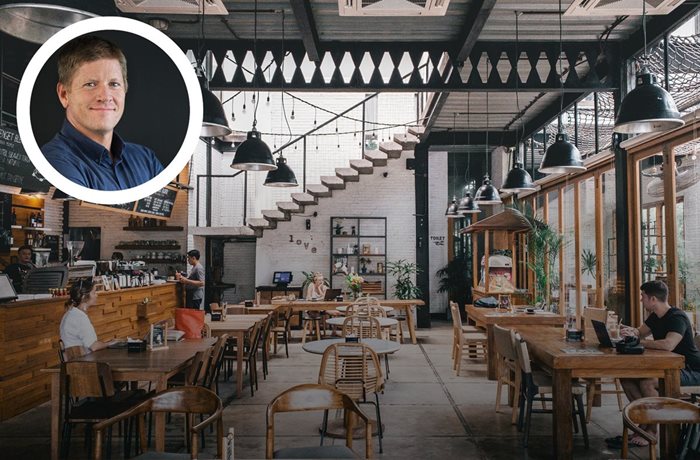In the latest issue of 5THWAVE magazine, Henry McGovern, co-founder of AmRest Holdings, shares four key questions to ask before investing in a hospitality business

Inset: Henry McGovern, Founder and former CEO, AmRest Holdings
Henry McGovern is best known for co-founding AmRest Holdings, one of the largest independent chain restaurant operators in Central and Eastern Europe, franchising prominent brands including Starbucks, Pizza Hut and KFC. AmRest went public in 2005, and by the time McGovern left the company in 2019, it operated some 2,000 restaurants across 26 countries.
Today, McGovern is an investor in a number of hospitality businesses that have potential for massive scale, including UK boutique bakery and coffee chain, Gail’s. Here, he outlines four essential qualities hospitality businesses must possess before considering an investment
1. Can it be internationalised?
When considering investing in a hospitality business, it is important the brand has the potential to appeal to a larger market audience. As brands build a customer base over a 3–5-year timeframe, their appeal will usually have a specific type – whether that’s an age demographic or gender based. If a brand can appeal to new customer bases in a local market, it’s usually a good indication it will be successful internationally.
We’ve made many missteps on that front over the years and getting the formula right when launching a brand internationally is tricky. Adapting to local tastes and customs by listening to customer feedback is essential to success – as is going in knowing that you must stay true to the brand while being ready to make changes – whether that’s to the menu or store format.
2. Can it be digitised?
Today, payment systems are critical to engagement. New FinTech systems that enable immediate payment to table, for example, can have a major positive impact on customer satisfaction. Five years ago, we wouldn’t have expected seamless transactions on a phone to make such a difference when it comes to delivering a positive customer experience. Today, frictionless transactions are essential when ordering and paying in a restaurant or coffee shop.
“We always had a rule that we would never grow a business more than 50% a year”
That’s why we look at a range of touch points in a business and ask how customers can be acquired and retained through digital technology. We examine how a brand engages with those customers digitally and whether the brand lends itself to as many digital touch points as possible.
We also ask if that customer interaction is sufficient that they want to download an app associated with a brand, and whether there is customer frequency and attachment to the brand that makes the transaction necessary. It helps if a business offers delivery because that provides another part of the payment system that customers expect to be digitalised.
3. Can it be scaled?
This starts with the people side first. We always had a rule that we would never grow a business more than 50% a year, which is already a lot. We had that rule in place because it is very difficult to build up the skilled people who will ensure growth doesn’t run off the rails.
You also need to get the financial model right and the business should be getting at least 20% internal rate of return (IRR) on its investments. Once that level is reached, you can then decide whether you want to leverage it or not. Anything above 20% IRR enables the business’ financing, whether that is from internal cash flows or augmenting with bank finance.
Case study: Gail's Bakery
Gail’s is a brand that possesses all the elements outlined here. It is a business that can be digitalised, as demonstrated by the successful roll-out of online delivery and click & collect. Its scalability is also proven. Even during the darkest days of the pandemic, Gail’s kept opening new stores. It also has a unique production system and a central baking facility to support further growth.
Gail’s has adamantly maintained the quality of its ingredients and making sure it has the best products on the market. Every time a new store is opened, the local community gets a taste for something better than they’ve had in the neighbourhood before. That drives brand commitment and affiliation and has popularised a particular flavour that customers have become accustomed to.
During difficult days of trading in 2020, the leadership team really stood out and drove the business’ positive culture. As a result, turnover among the senior team has been minimal because everyone feels that what they’re achieving is unique.
4. Is there a great culture?
Positive energy is critical in hospitality businesses. It’s a tough industry and staff know they’re going to face long shifts. That’s why the culture must be cooperative and engaging. Every day and across every single transaction, customers need to feel special and have a positive experience. To deliver that, staff need to be happy with the brand they’re working for.
When you work to create a brand and take pride in it, it puts you into the public domain. One of the fun things about the restaurant industry is that everyone has an opinion about a brand, whether good or bad. Perhaps the most critical aspect of running a restaurant is that people work for whoever their manager is – that’s why it is essential to build a sense of pride and ownership at the restaurant level.
We try to ensure that managers at each location have enough authority, responsibility and attachment to the brand to ensure a positive culture can thrive.
This article was first published in Issue 9 of 5THWAVE magazine.
Subscribe to 5THWAVE to receive each edition in print and digitally or sign up to our newsletter and be the first to read the latest articles and updates on World Coffee Portal research
